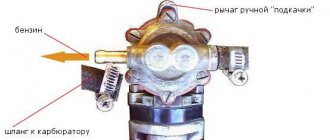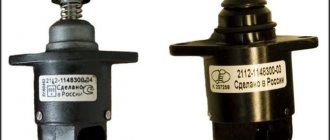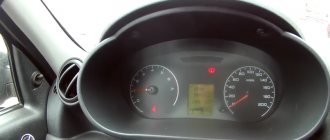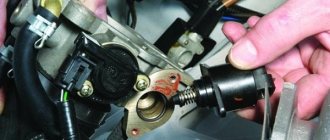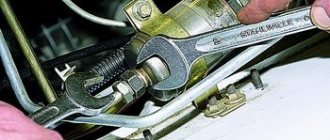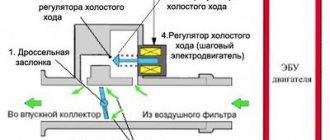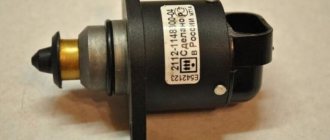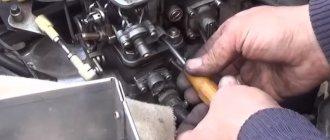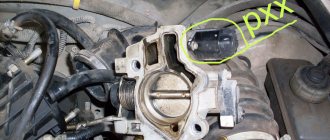Idle speed regulator VAZ 21214 injector where is it located
Removing the throttle assembly
The throttle assembly is removed to replace the idle air control or throttle assembly gasket. Disconnect the negative wire from the battery.
Partially drain the coolant.
Use a Phillips screwdriver to loosen the clamp securing the air hose to the throttle body.
Disconnect the air hose.
Loosen the clamp and remove the crankcase ventilation hose from the throttle body fitting.
Use pliers to loosen the clamps.
Remove the coolant inlet and outlet hoses from the throttle body fittings.
Loosen the clamp and remove the adsorber hose from the fitting.
Disconnect the throttle position sensor and idle air control connectors.
Disconnect the cable from the damper drive pulley.
Using a 13mm socket with an extension, unscrew the two nuts securing the throttle assembly to the receiver.
Removing the throttle assembly
The connection is sealed with a gasket
The air flow in the receiver is organized by a plastic sleeve.
The flat on the bushing should face the flat surface of the receiver
Install the throttle assembly in reverse order.
The tightening torque of the nuts is 15–20 Nm. Add coolant.
How to restore the idle speed sensor?
In some cases, in order to restore this part, it is enough to simply clean it thoroughly. Cleaning the sensor itself is a very easy process, and for repairs it is enough to have only WD-40.
So, how to restore the idle speed sensor on a VAZ 2112? At the first stage, the two nuts securing the throttle assembly are unscrewed. The latter, as in the case of replacement, is moved 10 millimeters to the side. Next, the wire block is disconnected from the sensor. WD-40 is applied to a cotton swab, and all channels are thoroughly cleaned with it. Next, use a Phillips screwdriver to unscrew the two bolts that secure the VAZ 2110 idle speed sensor. If there are no fasteners here, then you will have to remove the entire throttle assembly. Next, the mechanism itself is pulled out. If it is covered in oil and black dirt, then in addition to cleaning the throttle body, you will need to clean the entire throttle body.
Next, WD-40 is applied to a conical needle with a spring. Thus, after a few minutes the sensor mechanisms will be cleaned of dirt. Then the device is dried, and it can be safely installed in place. Before installation, check the distance from the needle to the body of the device (one should be 23 millimeters). Idle speed sensor VAZ 2110, 21214, the essence of the idle speed sensor and replacement. At this stage, the idle speed sensor of the VAZ 2115 can be considered successfully repaired. The machine can operate normally again.
So, we found out how the idle speed sensor of the VAZ 2114 (and other models) works. Idle speed sensor VAZ 2114, otherwise the sensor will need to be completely replaced. And how it can be replaced/restored.
Removing the idle air control
Remove the throttle assembly.
Using a Phillips screwdriver, unscrew the two screws securing the regulator to the throttle assembly.
Remove the idle speed control.
The connection is sealed with a rubber ring.
Install the idle air control in the reverse order.
With a new regulator, use a caliper to check the distance between the end of the valve needle and the mounting flange: it should be no more than 23 mm.
This is necessary in order not to damage the regulator during installation - the regulator needle should not rest against the seat of the throttle assembly.
Before installing the regulator, clean the valve seat, air channel and the surface under the regulator's sealing ring in the throttle assembly.
Lubricate the regulator O-ring with engine oil. The tightening torque for the regulator mounting screws is 3–4 Nm.
Source
Procedure for removing the device.
To remove this device, you need to stock up on a small set of tools, consisting of a 13mm socket wrench, a screwdriver and pliers.
- Place the vehicle on a flat surface and secure it with the parking brake. If there is any doubt about the stability of the car, you need to install wheel chocks.
- After this, you need to disconnect the battery terminals.
- We unscrew the fastening nuts and studs that secure the receiver to the throttle valve. In this case, there is no need to disconnect the pipes of the cooling and crankcase ventilation system.
- Disconnect the terminals from the wires
- Using a Phillips screwdriver, unscrew the valves on the throttle valve
- When the device mount is unscrewed, you can remove it from its seat. Usually, you can get the O-ring along with it. But, in some cases, it may get stuck in the damper well.
- In this case, it is necessary to carefully dismantle it.
But sometimes the device may be working properly, but problems in operation are associated with its clogging. In this case, you can try cleaning it with carburetor cleaner. Typically, this method helps to revive a device that has no visible mechanical damage. But this measure does not guarantee a 100% result, but is only temporary, which allows you to get to the nearest service station or store with spare parts.
The idle speed of the Chevrolet Niva may be incorrectly adjusted if the sensor has increased travel between the valve and the supporting surface. When measured with a caliper, this distance should not exceed 23 millimeters.
Compliance with these parameters is necessary in order to ensure correct installation and not damage the throttle body.
Before installation, the seat must be cleaned. You can also lubricate the O-ring with engine oil to make it easier to put it in place.
Throttle sensor.
The Niva Chevrolet throttle sensor can also affect the smooth operation of the engine at idle. This component controls the amount of air mixture that enters the cylinders. The main task of this part is to make this quantity optimal for high-quality ignition.
The Chevrolet Niva throttle valve is regulated by a special sensor, which, if necessary, closes it, forming a vacuum in the intake system, or opens it, allowing the air mixture to pass through.
If the TPS is faulty, then malfunctions occur during idling. In this case, you need to remove the element and carry out diagnostics.
1. First you need to disconnect the wire block to de-energize the sensor
2. To check its functionality, you need to use a multimeter to measure the voltage between the first and third connectors in the block. In this case, you need to move the damper position from closed to open.
3. The element itself is secured with 2 screws, which need to be unscrewed for replacement.
4. After removing the element, check whether there is an o-ring left in the seat. You need to check its appearance and if everything is in order, install it in place.
5. Now you can install the new part and reassemble in reverse order.
Description of IAC
Operating principle of the IAC The
idle speed regulator was installed only on Nivas with fuel injection and a mechanical throttle. When installing an electronic throttle, IAC is not used, since the entire IAC process is controlled electronically.
The regulator is designed to regulate engine speed at idle by adjusting the air supplied to the cylinder head. The IAC is a DC motor with a worm gear on the shaft, which has a cone installed that regulates the air supply through the IAC channel in the throttle assembly.
This sensor is quite unreliable, often subject to breakdown and replacement. Due to its unreliability, it was subsequently abandoned in favor of an electronic throttle.
Replacing the idle speed control on a Niva Chevrolet: signs
While the engine is idling, air is supplied to the engine using the idle speed regulator. This device is a two-pole stepper electric motor, with a cone valve connection. And when the ECU sends a signal to the regulator, it moves the valve, limiting the passage of air through the channel.
Please note that this device is non-separable, and when it fails it must be completely replaced; it is also worth noting that its dismantling must be done only after inspecting and removing the entire throttle assembly.
IAC device
The idle speed control is a DC motor. Below is a diagram describing the parts that make up the Niva IAC.
- Movable air flow valve;
- IAC fixing plane;
- Winding;
- Shaft with worm gear;
- Output (connector);
- Sleeve;
- Frame;
- Anchor;
Checking the IAC Niva
Checking this sensor to accurately identify its failure must be carried out in two ways: visual inspection and multitherm testing. Let's look at each of the checks in more detail.
Visual inspection
This check is carried out only after removing the IAC from the remote control.
It is necessary to check the condition of the regulator body; there should be no chips, cracks or gaps between the metal and plastic parts.
The presence of all rivets securing the plastic part of the sensor is checked, since the absence of a rivet may be accompanied by the passage of air.
Check the condition of the rubber sealing ring. There should be no burrs or cracks on it.
The mobility of the worm shaft is checked. He should move around without biting.
Check that there is no carbon deposits on the regulator cone.
Checking with a multimeter
Since the sensor is mechanical and, in principle, its design is based on a conventional DC motor, the test is carried out by measuring the resistance of the IAC winding.
To check on a multimeter, set the switch to measure a resistance of 200 ohms.
We connect the multimeter probes to the central terminals of the IAC and measure the resistance on them. The reading on the device screen should be close to 50 ohms. If the device shows 1 or infinity, then most likely a winding break has occurred.
If the winding breaks, the idle speed regulator VAZ 2121-2123 must be replaced with a new one.
Replacing the sensor
Replacing the idle speed regulator on a Niva is quite simple and easy. To complete this procedure without error and with ease, we recommend following the instructions below.
Replacement process
- Disconnect the negative terminal from the battery. This is necessary to avoid short circuits during operation.
- Remove the connector from the sensor.
- Unscrew the two cross-shaped screws securing the regulator to the throttle body.
- We remove the regulator from its seat.
- Installing a new regulator is done in the reverse order. Be careful and don't forget to install the O-ring. Without this rubber ring, the remote control will not be sealed and unwanted air leaks are possible.
Source
Signs of a malfunction of the idle speed sensor in a Chevrolet Niva
A malfunction of the idle speed sensor in a Chevrolet Niva has pronounced symptoms - the power unit stalls, engine speed fluctuates after starting or drops below 500 RPM. This behavior of the engine causes significant inconvenience to the driver. Therefore, every car enthusiast knows how to diagnose an IAC malfunction and replace it if necessary.
Content
- Types and designs of IAC in Chevy Niva
- How the regulator works and where it is located
- Signs of trouble
- Causes of malfunctions
- Features of diagnosing the idle speed sensor
- How to replace the idle speed sensor in a Chevrolet Niva
- Conclusion
How to replace the idle speed sensor on a VAZ 21214 (Niva)
The regulator, idle speed sensor Niva-21214 injector is responsible for the cold start of the engine and its operation at low speeds when the gear is off. Previously, on carburetors, these functions were performed by 2 units: an air damper with a cold start membrane and an electric valve with an idle jet.
To some extent, diagnosing malfunctions was easier than after the advent of the electronic fuel control system. Nevertheless, if you wish, you can also understand it in order to detect problems with the regulator and fix them yourself.
Element location and operating principle
In fact, the term "sensor" is not very suitable for the name of this element, since it does not measure any parameters. It is more correct to call the device the idle speed controller VAZ-21214. This is a small unit with a stepper motor built inside, to which a retractable rod is attached. At the end of the rod there is a spring-loaded valve in the form of a cone, whose task is to block the cross-section of the channel where the air moves.
As in carburetors, the operation of an engine with an injector at idle is ensured by a separate system, where the main role is played by a regulator controlled by a controller. The air supply control unit has a special channel that bypasses the throttle valve. That is, the Niva’s power unit idles with the throttle completely closed, while air enters the injector through the bypass. This is where the VAZ-21214 idle speed sensor is located; its task is to increase or decrease the air flow passing through the bypass at the command of the controller. To start a cold engine, it is always necessary to supply an enriched mixture to the cylinders, and as it warms up, gradually deplete it to normal. Previously, the issue was solved by closing the primary chamber using a damper, which caused a vacuum to arise in the manifold and the engine drew in more fuel.
Nowadays, fuel is supplied to the cylinders by injection, so when the engine starts, the algorithm for operating the fuel system is different, although the principle is the same:
- When the driver turns on the ignition, the fuel pump is activated, raising the pressure in the fuel line. At the same time, the controller turns on and takes readings from all sensors responsible for the operation of the power unit.
- Based on the readings of the temperature sensor, mass air flow and throttle position, the controller understands that the engine is cold and a rich mixture needs to be prepared to start.
- After turning on the starter, the controller commands the idle air regulator to close most of the channel so that the air-fuel mixture is as rich as possible (lots of gasoline and little air). After which it injects fuel into the cylinders, supplying a spark to the spark plugs.
- The engine starts, the processor immediately sets it to 1000-1200 rpm for warming up, guided by the mass air flow sensor and the crankshaft position. In this case, the idle air control slightly opens the passage for air in the channel.
- As the engine warms up, its temperature rises, which is what the controller “sees” using a temperature sensor. It commands the regulator to open a larger cross-section for air, and it supplies less fuel to the cylinders. Thus, the mixture gradually becomes leaner, and the engine idle speed is reduced to 850 rpm.
Types and designs of IAC in Chevy Niva
The idle speed sensor, also known as the valve or idle speed controller (IAC), is an actuator responsible for supplying air to the intake manifold to maintain idle speed within the limits specified by the manufacturer. As a rule, the IAC maintains from 700 to 900 crankshaft revolutions per minute at idle. In warm-up mode, the number of revolutions is higher.
The Chevrolet Niva is equipped with IAC with the index 21203-1148300, which is also suitable for other AvtoVAZ all-wheel drive models (4x4 and Nadezhda) with an engine capacity of 1.7 to 1.8 liters. The factory IAC is equipped with a stepper motor, which is connected to the valve responsible for the air supply. The valve tip is made in the form of a metal rod with a needle at the end. To increase reliability, the regulator is equipped with a steel tip, which increases its service life and allows the use of gas-cylinder equipment on the Niva.
We check the idle speed sensor of the Chevrolet Niva. Replacement with a new one
Any breakdown in a car requires a timely solution, as it can lead to more serious problems. Sensors in a modern car are one of the most important measuring devices.
The failure of at least one of them leads to the fact that the ECU is not able to obtain a complete picture of the progress of the system.
Operating principle of the idle speed sensor
The idle speed sensor, otherwise known as the regulator (IAC), allows you to select the optimal crankshaft speed depending on the specified conditions.
If this part breaks down, the rhythm of the engine’s operation is disrupted, since a sufficient amount of air does not enter the combustion chamber, or a too lean mixture is formed, as a result of which the engine speed begins to float, this is especially noticeable at idle speed.
The principle of operation is as follows: the air mixture flow sensor (MAF) determines how much air has entered the combustion chamber, after which the electronics calculates how much fuel needs to be supplied to the injectors.
The IAC increases the air supply so that the engine quickly warms up to the optimal temperature, or you can start driving without fear of stalling.
Where is the idle speed sensor located on a Chevrolet Niva
On the Niva 2123, the idle speed control is made in the form of a small electric drive with a spring and a rod ending in the form of a needle, which are enclosed in one housing.
The IAC is attached to the throttle body. The sensor starts working when the key is turned in the ignition switch.
At this moment, the rod rests against a special hole to count the necessary steps, after which the valve returns to its original position.
How the regulator works and where it is located
The Niva idle speed control is integrated into the engine throttle valve and attached to the throttle body using two threaded screws.
The operating principle of the regulator is as follows:
- As soon as the engine is started, the electronic control unit measures the temperature of the power unit and gives a command to maintain the standard crankshaft speed at idle when the gear is not engaged and the throttle valve is closed.
- The Chevrolet Niva IAC maintains the required speed using a stepper motor, which sets the desired channel diameter by extending the rod and increasing or decreasing the diameter of the bypass channel. If the engine is not warmed up, the IAC increases the engine speed; if it is warmed up, it maintains the required amount.
- As soon as the throttle valve opens, air begins to flow into the intake manifold through it. When the throttle valve is closed, the transmission is disengaged, and the engine is not turned off, air begins to flow again into the intake manifold through the idle air control.
- At the same time, the IAC plays the role of a load regulator when energy consumers, for example, a stove or headlights, are turned on. If the load increases, the IAC increases engine speed, thereby compensating for the loss of power.
Signs of trouble
A faulty Chevy Niva idle speed control has similar symptoms to a faulty throttle position sensor. Therefore, during further diagnostics it should be determined that the problems lie precisely in the IAC.
Signs of IAC malfunction:
- unstable operation of the power unit at idle until the engine stops;
- engine tripping;
- difficulty starting the engine, which is facilitated by pressing the accelerator pedal and adding gas;
- a drop in speed below 500 RPM when the stove, headlights, and other energy consumers are turned on;
- During a cold start, there is no increase in engine speed.
Reference. The malfunction of the Chevrolet Niva idle speed control does not have any specific features compared to other brands and models of cars.
Purpose and design of the VAZ idle speed control
A malfunction of the idle speed control will not allow the car to continue moving fully. During normal normal operation, the engine stalls only after the driver turns off the ignition using the key. If the car stops while the engine is on, it should continue to operate at minimum speed, or, as they say, at idle. It is the idle speed regulator that ensures stable engine speed while parked, so its malfunction will lead to the car stalling as soon as the gas pedal is released.
The idle speed control is located on the throttle valve next to the position sensor. The regulator body has a cylindrical shape with a mounting flange adjacent to the throttle body and fixed with two or three screws, depending on the modification. In the front part of the device there is a rod, with the help of which the operation of the motor is controlled. The rear part of the housing is equipped with electrical connectors through which the electronic control unit monitors and controls the regulator. The engine speed is set automatically by the electronic system and changes depending on the operating conditions of the power unit.
Idle speed regulator VAZ-2112 PEKAR
Idle speed regulator VAZ-2112 KZTA
Idle speed regulator VAZ-21203, 2123 KZTA
Idle speed regulator VAZ-21203,2123 PEKAR
Idle speed regulator VAZ-2112 PEGASUS
Idle speed regulator VAZ-21214,2123 in Lada-Standard packaging
Idle speed regulator VAZ-2112 in Lada-Standard Tolyatti Vento package
Causes of malfunctions
Since the IAC itself is a fairly simple device, there are few reasons for its malfunctions. These include:
- physical wear of the component parts, primarily the stepper motor and valve stem;
- open circuit of the valve power supply;
- burnout of the stepper motor winding;
- destruction of the sealing ring.
Reference. Also, improper operation of the idle air regulator may be due to contamination of the unit. Carbon deposits can clog the bypass channel and get inside the sensor. As a result, the regulator begins to jam during operation.
How to replace the idle speed sensor in a Chevrolet Niva
Replacing the idle speed control on a Chevrolet Niva is required if the part fails. The device is non-separable and can be completely changed. When choosing a new IAC, you should pay attention to the factory index. Only IACs containing code 21203-1148300 in the index are suitable. The specific suitable model can be found in the car's owner's manual.
To change the regulator, you must perform the following sequence of actions:
- The car is placed on a flat surface and the parking brake is applied.
- Before replacement, you should disconnect the negative terminal of the battery, thereby de-energizing the electronic control unit.
- Then the engine protective cover is removed.
- The fastening is loosened and the cable running from the accelerator pedal to the throttle assembly is disconnected.
- The nuts securing the throttle assembly are unscrewed, after which it is dismantled entirely.
- The idle air control connector is disconnected.
- Using a Phillips screwdriver, unscrew the screws securing the IAC to the throttle assembly.
- The regulator is removed from the mounting socket in which the new IAC is installed.
- Next, assembly is performed in reverse order.
Important! At the same time as replacing the sensor, you can clean the throttle assembly from accumulated dirt and carbon deposits.
After installing a new IAC, it needs to be calibrated. Calibration is performed by turning the ignition key for 5-10 seconds, without needing to start the engine. The new regulator regulates itself. After this, you can start the engine and observe the idle speed of the engine.
Chevrolet Niva: how to change the idle air control
There is a certain sequence of actions when replacing:
Similar articles
VAZ car sensors
- all pipes are disconnected from the throttle valve
, the block itself is unscrewed and removed; - the barrel-shaped part with a flange is secured with two screws. They unscrew, and the regulator itself is carefully pulled out along with the gasket;
- It is necessary to measure the length of the new sensor rod from the flange. It should be no more than 23 mm. If the rod is longer, it must be retracted by briefly applying voltage to contacts D and C;
- the installation site is cleared of dirt, the gasket is lubricated with motor lubricant, a new block is installed;
- After replacement, the throttle valve
is installed back, the pipes are connected, and the engine is started for testing.
Chevrolet Niva idle speed sensor signs of malfunction.
Sometimes the cause of regulator failure is contamination. In this case, you need to clean it. Cleaning is carried out with a special liquid for the carburetor, which is sold in spray cans. On the removed sensor, wipe the contacts of the electrical connector using a cotton swab, which must first be moistened in the cleaner.
| 825 posts on previous pages |
Reg.: 12/06/2004 Topics / Messages: 4031 / 23190 From: Moscow Age: 65 Car: 21214M, 2013
Alexey aka ALER.
Name: Alexander Reg.: 03/22/2012 Topic / Messages: 1 / 1088 From: Nizhny Novgorod Age: 53 Car: Was VAZ-21213-1995. There is a VAZ-21214M 2009. and will be.
Name: Evgeniy Reg.: 03/26/2008 Topics / Messages: 117 / 4705 From: Irkutsk Age: 34 Car: Jimny 2013
MartiNN
The photo is not yours, but from the Internet?
РХХ 21203-1148300 and 2112-1148300 are not interchangeable and the Niva should have exactly 21203 or 2112 with the stock rearranged from 21203.
With 2112 installed, there are usually surprises in the form of high XX revs and the like. Of course, everything there could become overgrown with dirt over time.
If the IAC had a non-retracted rod and was installed directly into place, then it could simply break.
The revolutions when changing gears on a working car should “freeze” for a short time.
Reg.: 01/25/2010 Topics / Messages: 1 / 1171 From: Tomsk region Age: 30 Car: VAZ-21310 2007
Added after 1 hour 37 minutes 21 seconds:
In general, after removing the damper position sensor and IAC, is any training necessary? It is necessary on an electronic pedal, I encountered this on a working Focus, but on a cable?
Name: Evgeniy Reg.: 03/26/2008 Topics / Messages: 117 / 4705 From: Irkutsk Age: 34 Car: Jimny 2013
As far as I remember, it can freeze at fairly decent (by ear) speeds. This is usually not noticeable during operation unless you spend too much time switching.
There is no training, the controller will figure it out on its own.
On a minibus, you can only check that the throttle position with the pedal released is 0 and see if the change is adequate when the pedal is pressed, maybe something is really sticking.
And you should also look at the position of the IAC, if the shuttle bus can display it at all (the manual has nominal ranges of values, but you only need to look at the manual specifically for your controller). Or you don’t have to look, all this doesn’t look like a problem with IAC at all.
Reg.: 01/25/2010 Topics / Messages: 1 / 1171 From: Tomsk region Age: 30 Car: VAZ-21310 2007
Reg.: 12/06/2004 Topics / Messages: 4031 / 23190 From: Moscow Age: 65 Car: 21214M, 2013
Alexey aka ALER.
Name: Alexander Reg.: 03/22/2012 Topic / Messages: 1 / 1088 From: Nizhny Novgorod Age: 53 Car: Was VAZ-21213-1995. There is a VAZ-21214M 2009. and will be.
On the Internet I found the simplest scheme for checking IAC - everything is simple and clear, and most importantly it works:
What it looks like, buzzes and “shoots”:
MartiNN
I immediately said change it! Good luck
Reg.: 01/25/2010 Topics / Messages: 1 / 1171 From: Tomsk region Age: 30 Car: VAZ-21310 2007
Reg.: 12/06/2004 Topics / Messages: 4031 / 23190 From: Moscow Age: 65 Car: 21214M, 2013
